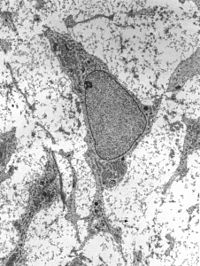
Photo from wikipedia
Populations of neural stem cells (NSCs) reside in a number of defined niches in the adult central nervous system (CNS) where they continually give rise to mature cell types throughout… Click to show full abstract
Populations of neural stem cells (NSCs) reside in a number of defined niches in the adult central nervous system (CNS) where they continually give rise to mature cell types throughout life, including newly born neurons. In addition to the prototypical niches of the subventricular zone (SVZ) and subgranular zone (SGZ) of the hippocampal dentate gyrus, novel stem cell niches that are also neurogenic have recently been identified in multiple midline structures, including circumventricular organs (CVOs) of the brain. These resident NSCs serve as a homeostatic source of new neurons and glial cells under intact physiological conditions. Importantly, they may also have the potential for reparative processes in pathological states such as traumatic spinal cord injury (SCI) and traumatic brain injury (TBI). As the response in these novel CVO stem cell niches has been characterized after stroke but not following SCI or TBI, we quantitatively assessed cell proliferation and the neuronal and glial lineage fate of resident NSCs in three CVO nuclei-area postrema (AP), median eminence (ME), and subfornical organ (SFO) -in rat models of cervical contusion-type SCI and controlled cortical impact (CCI)-induced TBI. Using bromodeoxyuridine (BrdU) labeling of proliferating cells, we find that TBI significantly enhanced proliferation in AP, ME, and SFO, whereas cervical SCI had no effects at early or chronic time-points post-injury. In addition, SCI did not alter NSC differentiation profile into doublecortin-positive neuroblasts, GFAP-expressing astrocytes, or Olig2-labeled cells of the oligodendrocyte lineage within AP, ME, or SFO at both time-points. In contrast, CCI induced a pronounced increase in Sox2- and doublecortin-labeled cells in the AP and Iba1-labeled microglia in the SFO. Lastly, plasma derived from CCI animals significantly increased NSC expansion in an in vitro neurosphere assay, whereas plasma from SCI animals did not exert such an effect, suggesting that signaling factors present in blood may be relevant to stimulating CVO niches after CNS injury and may explain the differential in vivo effects of SCI and TBI on the novel stem cell niches.
Journal Title: Journal of neurotrauma
Year Published: 2018
Link to full text (if available)
Share on Social Media: Sign Up to like & get
recommendations!